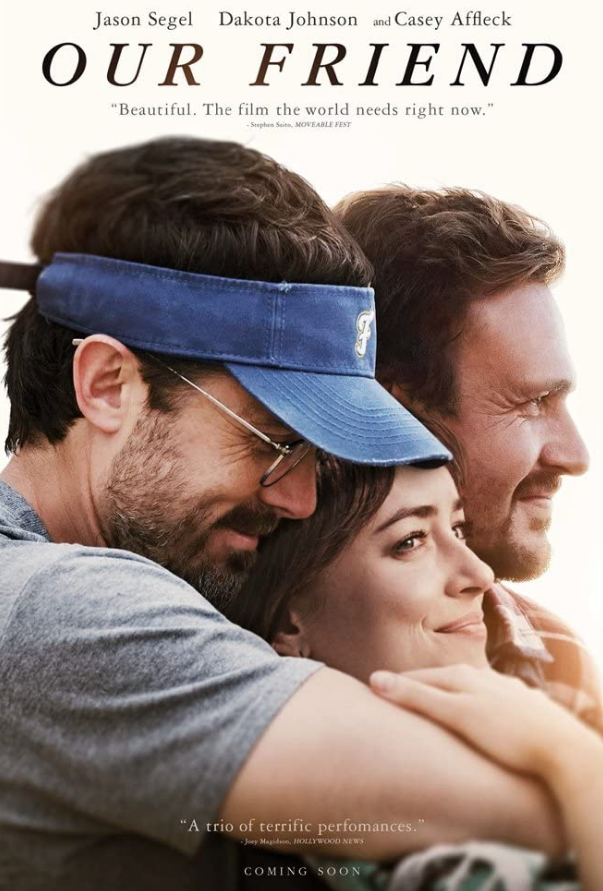In 2015, Matthew Teague published an essay in Esquire magazine. The entry-point was about his wife’s cancer-diagnosis and untimely death, but the essay’s focus was the way that one of their friend’s became a dependable fortress that helped the family through the ordeal. The essay is a moving read that speaks to the value of adult friendships in a way that’s not often explored, and the earnest sincerity of the piece seemed like a natural fit for a film adaptation.
Even as “Our Friend” is an adaptation of an essay that explores terminal illness from a different angle, the film is joining a subset of films about cancer that feels impossible to ignore. You know the kind. Some are good, some are not. But there is a familiar cadence to films about cancer – the diagnosis, the suffering, the aftermath, and the acceptance And even as “Our Friend” might be whittled down to the ways it falls into those patterns, the film is dependent on the ways that it recognises the most unceasing aspects of Teague’s essay – the significance of empathy.
Director Gabriela Cowperthwaite privileges sincerity above all else and that sincerity is key to the way that “Our Friend” examines the intersection of its key character. Jason Segel is Dane, the titular friend, a congenial if occasionally hapless man who’s the amiable third-wheel in the marriage of Matt and Nicole (Casey Affleck and Dakota Johnson in a pairing that surprises for how much it works). The trio have been connected since their younger years and their bond does not dissipate with time. When Nicole is diagnosed with cancer in the present-day of the film, the diagnosis threatens to rupture the lives of the couple and their daughters. The diagnosis gives Dane a sense of purpose, and he thrusts himself into supporting the family in ways that come to illuminate the value of their shared friendship.
Brad Ingelsby’s script follows a nonlinear pattern. The diagnosis comes early in the film, and after that the film weaves the present and the past into a restless tapestry as we come to make sense of the trio and the ways that they depend on each other. It’s a structure that lends itself to a looseness that sometimes feels discursive, but also feels realistically representative of the underlying sense of distress that marks the characters’ engagement with their lives.
The main way that the film divorces itself from Teague’s essay is by centring Dane. By virtue of his essay being personal, Teague’s article explores his personal state of mind in a way that Ingelsby’s script occasionally elides. Instead, “Our Friend” is most explicit about exploring Dane’s state of mind. Segel stretches his typical comedic chops in a role that asks him to play aspects of himself that are not always on display. For many, “Our Friend” will emerge as the film that marks a distinct shift in Segel’s onscreen persona. He’s good. He’s doing a valiant job at marrying Dane’s charming insouciance with a clear case of arrested development underlined with sadness
Cowperthwaite’s direction occasionally feels caught between the script’s interest in mining the darkness of Dane’s headspace with the presentation of the joyous warmth of the trio’s early days. But that empathy of her direction is key, and the lived-in feeling runs through the film as Cowperthwaite finds distinct moments of chemistry with the film’s entire cast – beyond the main trio. Even as Ingelsby’s script privileges Dane, it’s Affleck who emerges as the film’s secret weapon. “Our Friend” is not quite a comedy; even as those flashback sequences work towards something like joyfulness, the film works towards sincere melodrama and Cowperthwaite’s directorial instincts reflect that in the ways she does not turn grief into a parade.
And, it’s Affleck’s very internal performance that feels most in tune with Cowperthwaite’s efforts. He threads the discomfort of Matt’s engagement with his grief, capped off by the film’s thoughtful arc of his daughter’s growing resentment. His scenes with Segel are some of the film’s best, which feels strange in a way that the central cancer patient sometimes feels almost peripheral. Johnson is good, although her role is the one that most resembles familiar presentations of cancer on screen. But Cowperthwaite utilises her natural warmth in ways that the film depends on – the adoration that ekes out from both Dane and Matthew needs to be justified and she does that.
The film flirts with many potential avenues and Cowperthwaite’s interest in characters, beyond the central trio pays off. Stage-performer Denee Benton, for example, deepens a short role in such ways that you find yourself yearning for her presence as she disappears in the second half. Marielle Scott is adding wells of empathy and complexity to the “girlfriend” role. Cherry Jones turns up late in the film and offers a scene of great clarity and sensitivity. And Gwendolyn Christie (who enjoys a fairly high billing for a brief role) threads a scene that could go off course, with a moving sense of import that features Segel’s best moment.
This is very much the potential tearjerker that its logline might suggest, but it’s a lot more empathetic and thoughtful than you might imagine. It manages to feel sweet without feeling overwrought or disingenuous, and there’s a modesty to its largest intentions that make it endearing. The film avoids some of the more harrowing moments of the original essay, but in some ways its suggestions of the worst parts of cancer feel enough. Its engagement with grief as inherent to living feels timely. Its premiere at the end of January feels like it could be potentially drowned by larger imminent releases with more Big Issue focus but “Our Friend” is gentle and compelling in its modesty.
Our Friend will be released on VOD on January 22.







